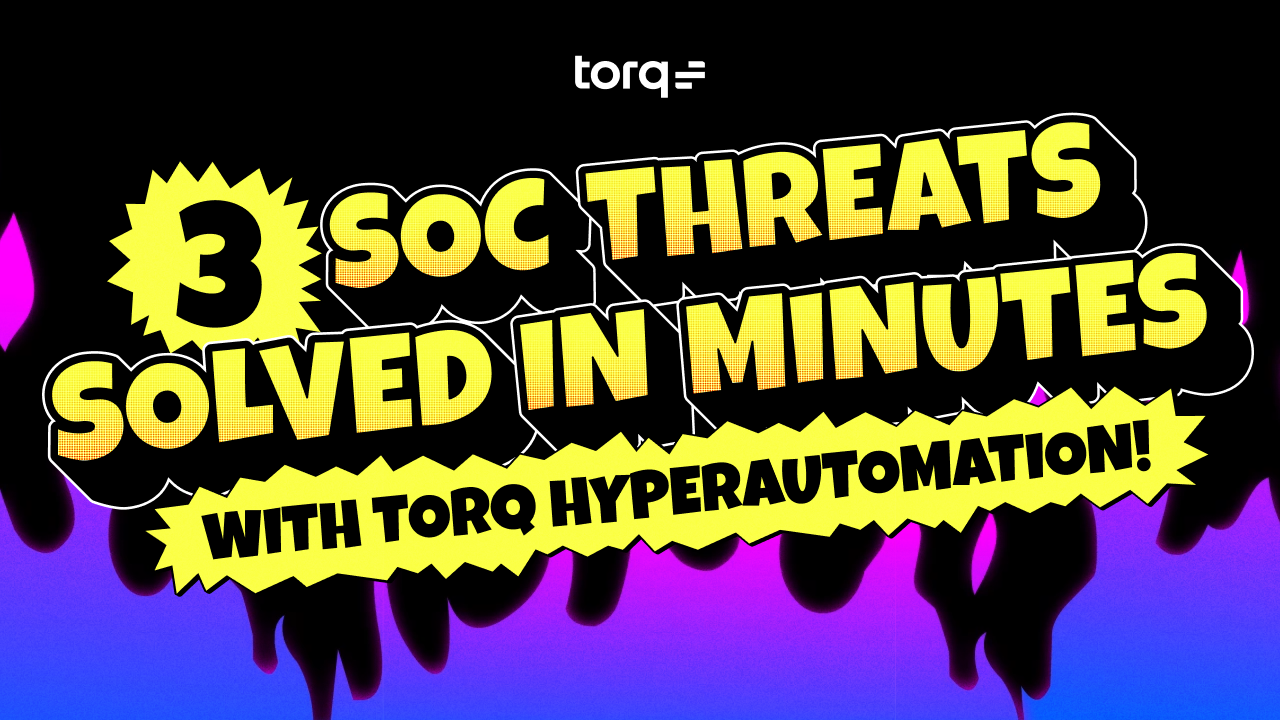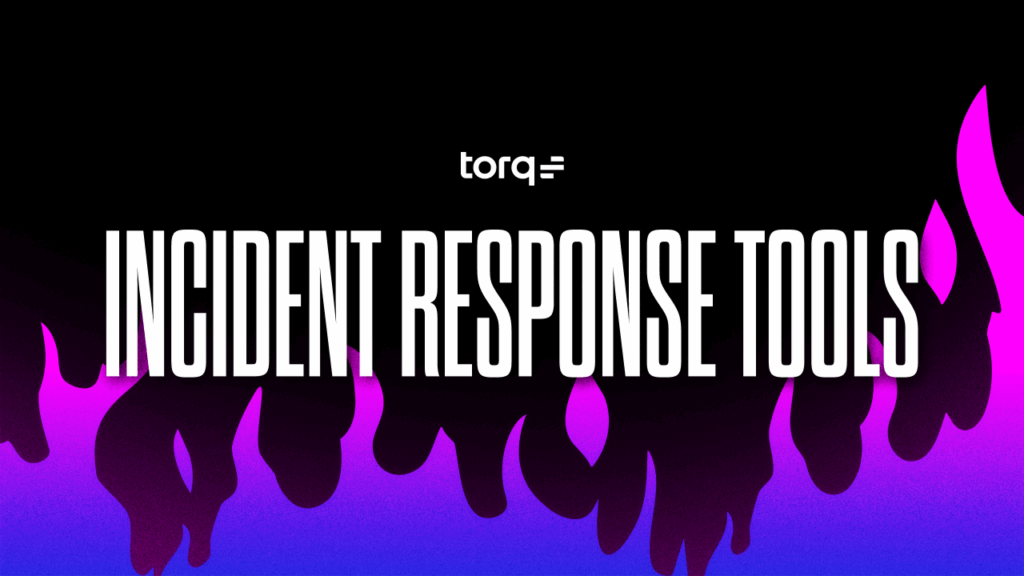Contents
Get a Personalized Demo
See how Torq harnesses AI in your SOC to detect, prioritize, and respond to threats faster.
Your SOC exists for one core reason: to rapidly reduce the mean time to detect, investigate, and respond to threats. The more efficiently your team operates, the faster you reduce essential KPIs like MTTR, MTTD, MTTI, and what we call ‘MTTx’ (mean time to anything).
Ask our former Field CISO, Patrick Orzechowski (PO), and he’ll tell you straight: If your SOC isn’t relentlessly focused on reducing risk through speed, you’re falling behind.
Talking about efficiency is easy. Actually achieving it, especially when your SOC is drowning in alerts and your analysts are burning out, is another story entirely.
The solution lies in combining Hyperautomation, agentic AI, and intelligent case management. Below, we break down three use cases where Torq HyperSOC™ and Socrates, the AI SOC Analyst, reduce MTTR to just minutes.
The SOC Efficiency Challenge
Reducing MTTR is a top priority for SOCs, yet many struggle to make meaningful progress. The root of the problem lies in legacy SOC environments’ outdated, manual, and disconnected nature.
If you’ve spent time in a SOC, these pain points are familiar:
- Manual investigations slow everything down: Over half of security teams struggle with false positives and data overload. Analysts spend valuable time pivoting between tools, manually gathering context from logs, threat intel feeds, and asset databases. This “swivel-chair” approach introduces friction at every stage of the investigation.
- Siloed tools don’t talk to each other: Most SOCs operate across dozens of disconnected platforms — EDR, SIEM, IAM, CMDB, ticketing, and more — without unified visibility or shared context. This makes correlating events and making informed decisions harder and slower.
- High alert volume leads to fatigue: Teams receive thousands of alerts daily, many of which are false positives. Sifting through the noise to find true threats overwhelms even the most seasoned analysts, increasing the time it takes to detect and resolve incidents.
- Disjointed shift handoffs cause delays: Without standardized processes or automated case management, investigations are often paused or reset between analyst shifts. Critical details get lost, increasing downtime and dragging out resolution timelines.
- Inconsistent processes and tribal knowledge: The lack of documented workflows and reliance on individual expertise mean response varies from one analyst to the next. This inconsistency increases mean time to detect (MTTD), mean time to investigate (MTTI), and ultimately mean time to resolve (MTTR).
- Delayed escalation and decision-making: Analysts often wait for senior approval before containing threats, primarily when procedures aren’t codified. This slows the response and allows attackers to move laterally or escalate privileges.
These pain points slow your team’s reaction times and increase risk. But these barriers disappear when Hyperautomation, AI, and smart case management are unified.
Why Reducing MTTR Is the Key to SOC Efficiency
What is MTTR in Cybersecurity?
MTTR (Mean Time to Resolution) measures the average time it takes to detect, investigate, contain, and fully resolve a security incident — from when it’s identified to when it’s no longer a threat. It’s one of the most critical KPIs for security operations because it directly reflects how quickly a SOC can respond to threats and minimize damage.
Related metrics include:
- MTTD (Mean Time to Detect): How long it takes to identify that an incident has occurred.
- MTTI (Mean Time to Investigate): The time required to assess and understand the scope and severity of an incident.
- MTTR (Mean Time to Resolution): The full incident lifecycle — detection through response and resolution.
- MTTx: A flexible term for any “mean time to X” metric, such as mean time to contain, recover, or respond.
High MTTR leads to longer dwell times, greater risk exposure, and higher operational costs. Reducing MTTR means:
- Stopping attackers before lateral movement or data exfiltration
- Limiting downtime and business disruption
- Giving analysts time back to focus on proactive defense
Reducing MTTR is a direct path to stronger security, happier analysts, and a more efficient SOC.
How AI, Hyperautomation, and Case Management Can Reduce MTTR
Torq HyperSOC is an autonomous, cloud-native security operations platform designed to reduce MTTR by eliminating manual bottlenecks across the incident lifecycle. Built on the Torq Hyperautomation platform, HyperSOC combines:
- Agentic AI (Socrates) to autonomously triage, investigate, and resolve threats
- No-code/low-code orchestration for rapid integration with existing tools across SIEM, EDR, IAM, and SaaS environments
- Natural language processing (NLP)-powered automation for dynamic workflows, smart case management, and intuitive analyst interaction
How Automation Speeds Detection, Investigation, and Response
Every minute matters in security. HyperSOC uses automation to minimize time spent on repetitive and manual tasks, which directly reduces MTTR.
Automated threat detection eliminates wait time for analyst triage.
Instant data correlation reduces downtime spent stitching logs, alerts, and asset context.
Hands-free auto-remediation triggers the correct response playbooks based on the threat type.Audit-ready documentation is generated in real time, ensuring compliance and traceability.
Use Case #1: Neutralize a Reverse Shell Command & Control (C2) Attack
This example shows how Torq HyperSOC reduced MTTR from hours to under two minutes by automating detection, investigation, and containment, without human intervention.
Threat detection and autonomous response: When a Ruby-powered reverse shell (courtesy of njRAT) targeted an EC2 Linux instance, Socrates got to work. As Torq’s AI SOC Analyst, Socrates detected anomalous process behaviors and network connections, flagging the reverse shell command within seconds.
Real-time enrichment: Without waiting for analyst input, Socrates quarantined the EC2 host. The platform harvested file hashes, process trees, and destination IPs, then enriched them via threat intel feeds and internal CMDB lookups.
AI-generated reporting: Through a deep understanding of the environment and analysis of the remediation runbook associated with the detected use case, Socrates autonomously killed the malicious process in its tracks before the bad actor was able to spread laterally, exfiltrate sensitive data, or cause any further damage. In under two minutes, the HyperSOC dashboard included an AI-generated incident report with prioritized next steps and detailed documentation of every AI-driven action taken.
Result: The threat was detected and neutralized without manual intervention, reducing MTTR and allowing analysts to move on to higher-priority tasks.
Use Case #2: Reduce MTTR with Automated MITRE ATT&CK Tagging
Manually identifying and tagging MITRE ATT&CK tactics, techniques, and procedures is time-consuming.
Automatic TTP mapping: Socrates can streamline this process by automatically linking and tagging threats with relevant MITRE ATT&CK tactics, techniques, and procedures (TTPs).
Runbook recommendations: The AI Agent parses case data, file hashes, process names, network connections, and behavior patterns, and distills them into discrete observables. Socrates cross-references each observable against the latest MITRE ATT&CK framework — pinpointing the primary tactic and related sub-techniques and procedures. For each matched TTP, Socrates auto-tags the case, links to relevant playbooks, and correlates with past incidents that used the same methods.
Automated scoring: Finally, the AI generates a concise report section that shows:
- Tactic: TA0011 – Command and Control
- Technique: T1219 – Remote Access Software
- Procedure: njRAT reverse shell delivered via Ruby script on EC2 instance.
- Confidence: 92%
- Potential Impact: Successful execution of these TTPs can lead to unauthorized access and control of critical systems, leading to data breaches or disruptions.
- Next Steps: Trigger the containment playbook, notify the Tier-2 SOC analyst team, and run a full asset sweep.
Result: Analysts no longer spend time manually tagging or correlating cases, which helps reduce MTTR and increase consistency across investigations.
Use Case #3: Investigate and Close an Impossible Travel Alert in Minutes
Use Case #3: Investigate and Close an Impossible Travel Alert in Minutes
This case shows how Socrates cut MTTR from 20+ minutes to under three, replacing a manual investigation across multiple tools with a fully automated workflow.
Cross-platform checks: Okta flagged suspicious logins from Austria, Singapore, and Brazil for a single user within a 30-minute window, an impossible travel scenario indicating potential compromise.
Anomaly resolution: Socrates autonomously checked the user’s leave status in Workday and calendar systems. Next, Socrates messaged the employee on Slack, capturing their response directly into the case notes. Simultaneously, it enriched each login IP against external threat intelligence feeds, scoring them for risk and historical malicious activity.
Automated case closure: Socrates then compared the session details against the user’s normal behavior baseline to spot anomalies. Finally, because the user had confirmed the unusual travel and all IP reputations returned legitimate, Socrates marked the alert as a benign true positive, documented the reasoning, and closed the case.
Result: MTTR was reduced to three minutes, false positives were resolved autonomously, and analysts stayed focused on real threats.
What These Results Mean for Your SOC
The use cases above aren’t isolated wins — they represent a repeatable, scalable model for transforming your security operations. When you reduce MTTR through AI, Hyperautomation, and intelligent case management, your SOC becomes faster, more resilient, and dramatically more cost-effective.
Proving the ROI of MTTR Reduction
Reducing mean time to resolution doesn’t just make your SOC more efficient — it delivers measurable business value:
- Faster resolution = less dwell time and downtime: The longer a threat lingers, the more damage it can do. By shortening the incident lifecycle, your team minimizes business disruption, data loss, and risk exposure.
- Fewer escalations = less analyst fatigue: Automating repetitive tasks and low-risk decisions reduces the volume of escalations sent to senior analysts. That frees them up to focus on high-value investigations — and helps reduce burnout.
- Higher accuracy = better threat outcomes: With real-time enrichment, contextual tagging, and autonomous decision-making, your SOC can respond more precisely, even under pressure. This leads to faster containment, fewer false positives, and stronger compliance reporting.
Operational resilience = higher ROI: SOCs that reduce MTTR gain more value from their existing tools and staff. You’re not just solving problems faster — you’re using fewer resources.
How to Start Automating Your SOC the Right Way
To reduce MTTR, you don’t need to rip and replace your entire tech stack. The best approach is incremental and targeted, focusing first on areas with high volume, low complexity, and high analyst fatigue.
Start by automating:
- High-volume alert triage: Automatically enrich, correlate, and suppress low-risk alerts based on historical context and threat intelligence.
- Repetitive enrichment tasks: Automated gathering of user context, asset data, geolocation, IP reputation, and vulnerability information can be done in seconds, not hours.
- Access investigations and policy violations: Build workflows that verify unusual access events across IAM, HR, calendar, and communication platforms, then take action based on policy.
These aren’t theoretical benefits; they’re proof points from the frontlines of modern AI-powered SOCs. When the powers of Hyperautomation, AI, and intelligent case management are combined in Torq HyperSOC, your team moves smarter and faster.
Instead of being bogged down, analysts are empowered to lead, strategize, and scale across complex environments. That’s how you reduce risk, retain talent, and prove real value.
Want to see HyperSOC in action? Book a demo now — and don’t miss our Field CISO’s guide full of practical advice for building a more efficient SOC.







